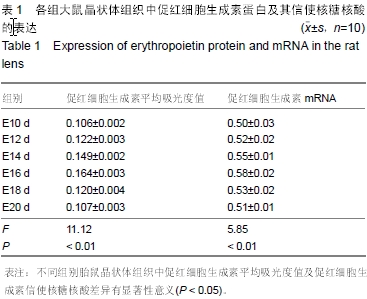| [1] Fisher JW.Erythropoietin: physiology and pharmalogy update. Exp.Biol.Med,2003; 228(1):1-14.
[2] Kawachi K,Iso Y,Sato T,et al. Effects of erythropoietin on angiogenesis after myocardial infarction in porcine. Heart Vessels.2012; 27(1):79.
[3] Letourneur A,Petit E,Roussel S,et al. Brain ischemic injury in rodents:the protective effect of EPO. Methods Mol Biol. 2013; (982):79.
[4] Vogel J,Gassmann M. Erythropoietic and non-erythropoietic functions of erythropoietin in mouse models. J Physiol. 2011; 589(Pt 6):1 259.
[5] Hu L,Yang C,Zhao T,et al. Erythropoietin ameliorates renal ischemia and reperfusion injury via inhibiting tubulointerstitial inflammation. J Surg Res.2012;176(1):260.
[6] Fu W,Liao X, Ruan J, et al. Recombinant human erythropoietin preconditioning attenuates liver ischemia reperfusion injury through the phosphatidylinositol-3 kinase/ AKT/endothelial nitric oxide synthase pathway. J Surg Res.2013;183(2):876.
[7] 陈琳.促红细胞生成素预处理对兔肺缺血再灌注损伤保护作用的实验研究[D].苏州:苏州大学, 2010:20-28.
[8] Joshi D, Tsui J, Ho TK, et al. Review of the role of erythropoietin in critical leg ischemia. Angiology.2010;61(6):541.
[9] Qin L, Xiang Y, Song Z, et al. Erythropoietin as a possible mechanism for the effects of intermittent hypoxia on bodyweight, serum glucose and leptin in mice. Regul Peptides. 2010;165(2):168.
[10] Sayyah-Melli M, Rashidi MR, Kaseb-Ganeh M, et al. The effect of erythropoietin against oxidative damage associated with reperfusion following ovarian detorsion. Eur J Obstet Gynecol Reprod Biol.2012;162(2):182.
[11] Ji YQ, Zhang YQ, Li MQ, et al.EPO improves the proliferation and inhibits apoptosis of trophoblast and decidual stromal cells through activating STAT-5 and inactivating p38 signal in human early pregnancy. Int J Clin Exp Pathol.2011;4(8):765.
[12] 韩志刚,俞婷婷,单利.促红细胞生成素及其受体在非小细胞肺癌中的表达及其与微血管密度的相关性[J].中华肿瘤杂志, 2012, 34(8):605-608.
[13] 王纯斌,周燕,唐云龙,等.老年血液肿瘤患者促红细胞生成素水平的变化及意义[J].中国老年学杂志, 2014,34(23):6607-6608.
[14] 岳文静,连海峰,刘成霞,等.促红细胞生成素肝细胞激酶受体相互作用蛋白基因与胃癌结直肠癌淋巴管生成初探[J].中华消化杂志, 2013,33(8):554-556.
[15] Fu QL, Wu W, Wang H, et al. Up-regulated endogenous erythropoietin/erythropoietin receptor system and exogenous erythropoietin rescue retinal ganglion cells after chronic ocular hypertension. Cell Mol Neurobiol 2008;28:317-329.
[16] Hernandez C, Simo R. Erythropoietin produced by the retina: its role in physiology and diabetic retinopathy. Endocrine. 2012; 41(2):220-226
[17] Grimm C, Wenzel A, Acar N, et al.Hypoxic preconditioning and erythmpoietin pmtect retinal neurons fmm degeneration. Adv Exp Med Biol. 2006;588:119-131.
[18] Becerra SP. Amaral J. Erythropoictin-an cndogenous retinaI survival factor.N EngI J Med.2002;347:1968-1970.
[19] Morilla M, Ohneda O, Yamashjta T, et al. HLF/HIF-2alpha is a key faclor in retinopathy of prematurity in association with erythropoietin. EMBO J.2003;22:1134-1146.
[20] 袁春燕,孟旭霞,牛膺筠.促红细胞生成素在大鼠视网膜胚胎发育中的表达变化[J].中华实验眼科杂志,2011,29(11):998-1001.
[21] Patel S, Rowe MJ, Winters SA.et aI. Elevated erythropoietin mRNA and pmtein concentfations in the developing human eye. Pediatr Res. 2008;63:394-397.
[22] Meng XX,Zhang Y, Niu YY.Retinal erythropoietin expression in embryonic and postnatal rats.Journal of Clinical Rehabilitative Tissue Engineering Research.2011;41(15):7715-7718.
[23] Jakobiec JA. Ocular anatomy, embryology, and teratology. the USA: Harper&Row publishers.1982; 356-368.
[24] Mikami Y. Reciprocal transformation of the parts in the developing eye-vesicle, with special reference to the inductive influence of the lens.ectoderm on the retinal determination. 2001;1939;51:253-256.
[25] Kuroda H, Wessely O, De Robertis EM.Neural induction in Xenopus:requirement for ectodermal and endomesodermal signals via Chordin,Noggin beta-Catenin, and Cerberus. PLoS Biol. 2004;2(5):E92.
[26] Utton MA, Eickholt B, Howell FV, et al.Soluble N-cadherin stimulates fibroblast growth factor receptor dependent neurite outgrowth and Ncadherin and the fibroblast growth factor receptor CO. cluster in cells. J Neurochem.2001;76:1421-1430.
[27] Vogel-Höpker A, Momose T, Rohrer H, Multiple functions of fibroblast growth factor-8(FGF.81 in chick eye development. Mech.Dev.2000;94:25-36.
[28] Yamamoto Y, Jeffery WR. Central role for the lens in cave fish eye degeneration. Science. 2000;289(5479):631-633.
[29] 胡迭,孟旭霞,王海韬,等.大鼠晶状体胚胎发育形态学变化及HIF-1α的表达.国际眼科杂志2014,14(11):1931-1934
[30] Ribatti D.Erythropoietin and tumor angiogenesis. Stem Cells Dev.2010;19(1) :1-4
[31] Liu Q, Davidoff O, Niss K, et al.Hypoxia-inducible factor regulates hepcidin via erythropoietin-induced erythropoiesis. J Clin Invest.2012;122(12):P. 4635-4644.
[32] Prass K. ScharfrA, Ruscher K, et al. Hypoxia-induced stroke to1erance in the mouse is mediated by erythropoietin. Stroke. 2003;34(8):1981-1986.
[33] 龚葳,吉训明,何士大,等, EPO在脑缺血神经保护作用中的研究进展[J].医学研究杂志,2008, 37(8):10-12.
[34] Villa P, Bigini P, Mennini T, et al. Erythropoietin selectively attenuates cytokine production and inflammatian in cerebral ischemia by targeting neuronal apoptosis. J Exp Med. 2003; 198:97l-975.
[35] Agnello D, Bigini P, Villa P, et al.Erythropoietin exerts an anti-inflammatory effect on the CNS in a model 0f experimengtal autoimmune encephalomyelitis.Brain Res.2002;952:128-134.
[36] Sakanaka M, Wen TC, MaIsuda S, et al.In vivo evidence that erythropoietin protects neurons from ischemic damage.Proc Natl Acad Sci.1998;95(8):4635-4640.
[37] Sinor AD, Greenberg DA.Erythropoietin protects cultured cortical neurons, but not astroglia, from hypoxia and AMPA toxicity.Neurosci Lett.2000;290(3):213-215.
[38] Solaroglu I, Solaroglu A, Kaptanoglu E, et al. Erythropoietin prevents schemia-reperfusion from inducing oxidative damage in fetalrat brain.Childs Nervous System, 2003;19(1):19-22.
[39] Bernaudin M, Marti HH, Roussel S, et al. A potential role for erythropoietin in focal permanent cerebral ischemia in mice. J cereb BloodFlow Metab.1999;19:643-651.
[40] Ribatti D, Vacca A, Roccaro AM, et al. Erypoietin as an angiogenic factor. Eur J Clin Invest.2003;33:891-896. |

